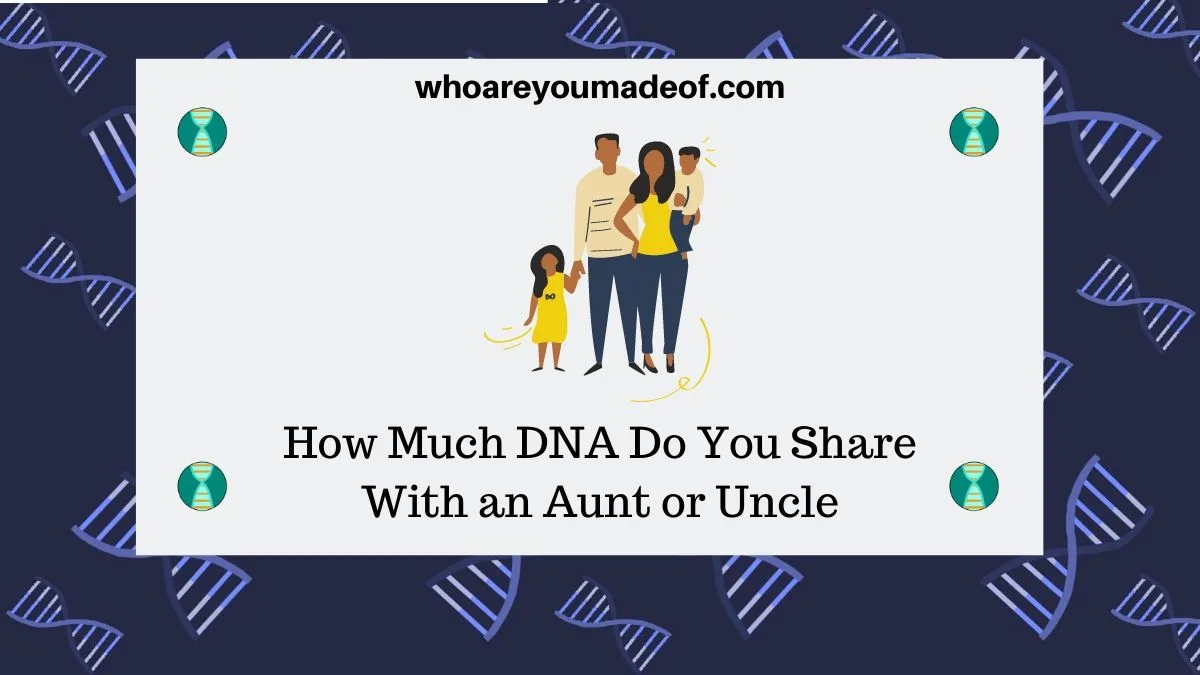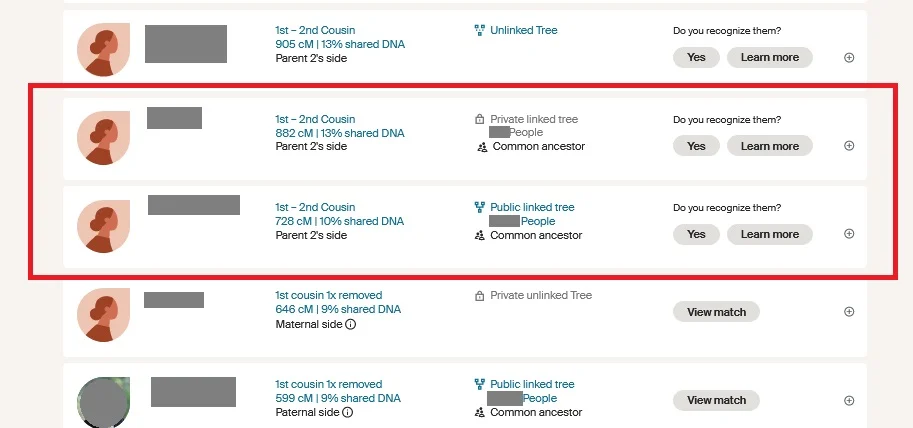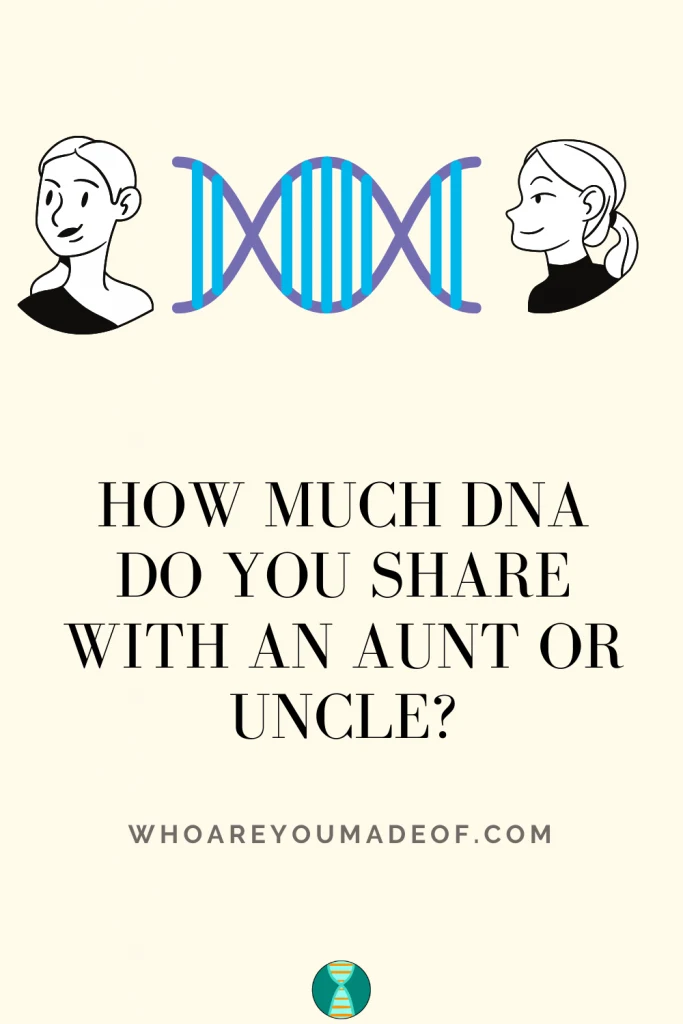Do you want to know how much DNA you share with an aunt or uncle? In this post, learn about the DNA shared with aunts and uncles, including information about half and full relationships.
You'll also find out:
- Why we don't share more DNA with our aunts and uncles
- Whether your aunt or uncle will have the same ethnicity results as you do
- How an aunt or uncle would show up on DNA results

As the popularity of DNA testing grows, we can expect to see more close relatives showing up on our match lists. The information in this post can help you better understand whether some of these new DNA matches could be an aunt or an uncle.
How much DNA do you share with your aunt or uncle?
A person will share between 1300 and 2300 centimorgans with their full aunt or uncle. Measured in percentages, we expect that an individual will share approximately between 19-33% of their DNA with these relatives.
It is important to know that there are other relatives that share 1300-2300 centimorgans with us. For example, half-siblings, grandparents, nieces and nephews, as well as grandchildren, also share DNA with us that falls within the same range.
Why don't we share more DNA with our aunts and uncles?
If our relative is a full-aunt or full-uncle, descended from both of our grandparents, why don't we share more DNA with them than just 19-33%? If they are full siblings of our parents, don't they share the same DNA?
The reason that we only share between 1300-2300 centimorgans with our parents' siblings is because siblings don't share 100% of their DNA with each other.
In addition, the way that DNA is passed down means that we will share significantly less DNA with our aunts and uncles than we do with our parents.
For example, full siblings will generally only share between 33% and about 50% of their DNA with each other. This is because each parent passes down a randomly selected 50% of their DNA to the child.
While a large portion of the DNA that two siblings inherit from their two parents will be identical, they will also inherit a great deal that is not the same.
Then, when one of the siblings has children, they only pass down half of their DNA to their child, meaning that only half of the approximately 33-50% that may have matched their sibling gets passed down to their offspring.
Since the DNA that gets passed down to their offspring is randomly selected, this explains the range of about 19-33% of shared DNA between aunts/uncles and nieces/nephews.
Should you share ethnicity regions from DNA results with your aunt or uncle?
While we can expect to share some ethnicity or ancestry regions with our aunt or uncle, we may notice big differences in our DNA results. Our aunt or uncle could have inherited some DNA from our grandparents matching parts of the world that don't show up on our DNA results.
Some of the DNA that our aunts and uncles have either was not passed down to our parents, or was not passed down from our parents to us. We can learn a lot by examining the ethnicity estimate of our aunts and uncles because we might be able to spot new regions that we don't have.
It should also be noted that ethnicity estimates should not be used to determine whether we share a full or half relationship with a relative, and it cannot be used to prove paternity, even from a previous generation. Examining the number of shared centimorgans is a much more reliable method.
Will we share all of our DNA matches with our aunt or uncle?
Since our aunts and uncles inherited DNA from our grandparents that didn't get passed down to us through our parents, we can expect that our aunts and uncles will have DNA matches that don't match us.
Even though our DNA match lists will not be identical to our aunts and uncles, all of our close DNA matches should also share DNA with our parents' siblings, as long as they are on the same side of the family.
We share DNA with essentially all of our relatives as distant as second cousins once-removed, and so we can expect to see most of these relatives shared in common, too. However, because we don't share DNA with all of our relatives, we might find distant cousin DNA matches for our aunts and uncles that don't match us.
The DNA that our aunts and uncles have that they don't share with us can match people that don't share DNA with us. These people are also likely related to us in a genealogical sense, but they won't be on our DNA match list or our genetic family tree.
How does an aunt or uncle show up on DNA results?
An aunt or uncle will show up towards the top of our DNA match lists. Exactly how they are labeled on our DNA results will depend on the company that we used to do our DNA test, and whether our aunt or uncle is a full aunt/uncle or a half-aunt/uncle.
For example, on Ancestry DNA, we will generally see aunts and uncles in the Close Family category. On My Heritage, we will see "Uncle" or "Aunt" as one of the possibilities in the "Estimated Relationship" section on our DNA match list.
Our half-uncles and aunts will likely show up in the Close Family category, too, even though they share less DNA with us than a full aunt or uncle.
Each DNA testing company displays DNA matches in a slightly different way. Regardless of the company we use to do our test, we should always expect to see aunts and uncles towards the top of our match lists because they are so closely related to us.
The image below show my first five matches on in one section of my Ancestry DNA results. The first match is a full first cousin to me, and the second two matches (indicated by the red rectangle) are two half-aunts on my mom's side of the family.

The bottom two matches are full first-cousins once-removed. One is on my mom's side of the family, and the other is on my dad's side of the family tree.
The estimated or predicated relationship, or the section where our aunts and uncles are on our DNA match list, are based on the amount of shared DNA that we have with our relative. In the example from my own DNA match list, if my aunts were full-aunts, they would show up before my first cousins on the list because we would share twice as much DNA.
Conclusion
I hope that this post has helped you understand more about how much DNA is shared between a person and their aunts and uncles.
If you have any questions about something that you read in this post, or if you would like to ask a specific question about shared DNA between us and our aunts/uncles, please join us in the discussion below.
Thanks for stopping by today!
Share with a pin!



Gillian Wareing
Monday 27th of November 2023
Hi I share 17% dna 1212 cMs across 27 segments with someone. What relation are they to me please
Dannell
Wednesday 13th of September 2023
Can DNA testing show I am the aunt of my deceased brother's daughter? A lady contacted me stating she believes my brother is her father from DNA testing she did. She states it points to my maiden name and that the name keeps showing up in her testing. Will a DNA test prove that I am her aunt?
Mercedes
Thursday 14th of September 2023
Hi Dannell, Thank you so much for your question. If an aunt and niece both take a DNA test with the same autosomal DNA testing company, such as Ancestry DNA or 23andMe, the amount of DNA shared could provide evidence for their relationship. Since an aunt/niece share a high amount of DNA, this will show up on the DNA match list if there is indeed a close relationship between the two people. I hope that this helps you, Mercedes
Diane
Wednesday 22nd of March 2023
I share 1829 cM with a match on Ancestry . I’ve ruled out grandparent/ grandchild . The only possibility would be Aunt/ Nephew or Half - Sibling but both fall in the same shared DNA RANGE !! I’m 65 he is 33 . I just found out who my biological father was using Ancestry unfortunately he passed away in 1997. I matched with several Aunts and cousins. I need to distinguish between half-sibling or aunt -nephew Diane
Jan
Sunday 4th of December 2022
Hi Mercedes! Thanks for another great article! Got a question for you. An Ancestry DNA match shares 15% DNA with 1,050 cMs across 28 segments, no endogamy. Its either a half aunt or half great-aunt (no chance of a cousin), with circumstantial evidence for both relationships. I'm leaning towards the half aunt relationship as the percent of shared DNA is high, but am examining all possibilities. Statistically speaking, might the DNA suggest a greater possibility of one relationship vs the other? Any input is appreciated. Thank you!
Mercedes
Thursday 8th of December 2022
Hi Jan, Thank you so much for your question! As for the probability of the match you described being a half-aunt or a FULL great-aunt, we can't make any determination between those two relationships based on only shared DNA. We would expect a half-great aunt or uncle to share less DNA, usually less than 700 cMs, and typically much less than that. There are other relationship possibilities at 1050 cMs, such as a half-niece, that could be explored. I hope that this helps you! Sincerely, Mercedes
Tammy
Tuesday 22nd of November 2022
Good afternoon hoping to get a better understanding on Aunt an uncle DNA . If your a full aunt and uncle meaning both grandparents of the niece are bio logical would results be lower if one grandparent was not the biological grandparent of the niece .